《哈姆雷特》 摘要
短篇小说投稿《哈姆雷特》的圣经内涵

短篇小说投稿《哈姆雷特》的圣经内涵摘 要: 本文以宗教信仰为视角,从伊甸园原型和替罪羊两个方面,阐述了莎士比亚在《哈姆雷特》一剧中表现出来的基督教精神,论证了圣经教义在莎士比亚安排故事情节、塑造人物形象时所起的重要作用。
关键词: 短篇小说投稿,莎士比亚,《哈姆雷特》 圣经 替罪羊在论及《圣经》对莎士比亚的影响时,英国学者柏格森曾这样评论过:“没有圣经,就没有莎士比亚。
”在莎士比亚生活的时期,始于亨利八世的宗教改革基本完成,这次改革取缔了教皇和天主教会的特权,但保留了天主教的基本教义和仪式。
基督教在人们的社会生活中发挥了更明显的主导性作用。
根据有限的资料记载,1546年4月26日出生的莎士比亚于英国斯特拉福德镇受洗,并被正式命名为“威廉·莎士比亚”。
莎士比亚早年,信仰天主教后改信新教的父亲安排他进入家乡的教会学校读书,主要学习基督教的宗教教义。
莎士比亚在充满浓厚基督教气氛的环境中长大,其生活和作品都呈现出清晰的宗教色彩,作为莎士比亚经典悲剧的《哈姆雷特》自然也不例外。
这部作品中传达圣经思想的人物话语比比皆是,整个故事情节是按照罪与罚、罪与赎的基本套路,处处折射作者莎士比亚的基督教人生观。
《哈姆雷特》全剧共有五幕,故事开始于午夜时分厄耳锡诺城堡前的露台。
此时夜深人静,寒风刺骨,只有城头的守望者偶尔低语。
他们所谈论的是一件让人毛骨悚然的鬼魂事件。
这鬼魂“穿着战铠,满面怒容,手持鞭杖,尽管一言不发,却让人心惊胆寒”[1]215。
哈姆雷特的好友,前来接替守卫之责的霍拉旭用恺撒遇害前的可怕征兆描述当下混乱的状况和可怕的未来:“披着殓衾的死人都从坟墓里出来,在街道上啾啾鬼语,星辰拖着火尾,露水带血,太阳变色,支配潮汐的月亮被吞蚀得好像一个没有起色的病人;这一类预报重大变故的征兆,在我们国内已经屡次出现了。
”[1]216接下来,与霍拉旭同来的接班人马西勒斯则描述了一幅平静安乐的景象:“我们的救主将要诞生以前,这报晓的鸟儿彻夜长鸣;那时候,他们说,没有一个鬼魂可以外出行走,夜间的空气非常清净,没有一颗星用毒光射人,没有一个神仙用法术迷人,妖巫的咒符也失去了力量,一切都是圣洁而美好的。
简析《哈姆雷特》的悲剧美
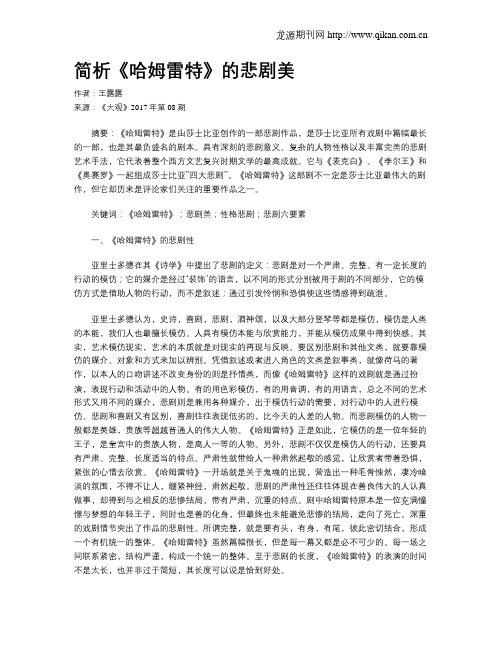
简析《哈姆雷特》的悲剧美作者:王露露来源:《大观》2017年第08期摘要:《哈姆雷特》是由莎士比亚创作的一部悲剧作品,是莎士比亚所有戏剧中篇幅最长的一部,也是其最负盛名的剧本。
具有深刻的悲剧意义、复杂的人物性格以及丰富完美的悲剧艺术手法,它代表着整个西方文艺复兴时期文学的最高成就。
它与《麦克白》、《李尔王》和《奥赛罗》一起组成莎士比亚”四大悲剧”。
《哈姆雷特》这部剧不一定是莎士比亚最伟大的剧作,但它却历来是评论家们关注的重要作品之一。
关键词:《哈姆雷特》;悲剧美;性格悲剧;悲剧六要素一、《哈姆雷特》的悲剧性亚里士多德在其《诗学》中提出了悲剧的定义:悲剧是对一个严肃、完整、有一定长度的行动的模仿;它的媒介是经过‘装饰’的语言,以不同的形式分别被用于剧的不同部分,它的模仿方式是借助人物的行动,而不是叙述;通过引发怜悯和恐惧使这些情感得到疏泄。
亚里士多德认为,史诗,喜剧,悲剧,酒神颂,以及大部分竖琴等都是模仿,模仿是人类的本能,我们人也最擅长模仿。
人具有模仿本能与欣赏能力,并能从模仿成果中得到快感。
其实,艺术模仿现实,艺术的本质就是对现实的再现与反映。
要区别悲剧和其他文类,就要靠模仿的媒介、对象和方式来加以辨别。
凭借叙述或者进入角色的文类是叙事类,就像荷马的著作,以本人的口吻讲述不改变身份的则是抒情类,而像《哈姆雷特》这样的戏剧就是通过扮演,表现行动和活动中的人物。
有的用色彩模仿,有的用音调,有的用语言,总之不同的艺术形式又用不同的媒介,悲剧则是兼用各种媒介,出于模仿行动的需要,对行动中的人进行模仿。
悲剧和喜剧又有区别,喜剧往往表现低劣的,比今天的人差的人物。
而悲剧模仿的人物一般都是英雄,贵族等超越普通人的伟大人物。
《哈姆雷特》正是如此,它模仿的是一位年轻的王子,是皇宫中的贵族人物,是高人一等的人物。
另外,悲剧不仅仅是模仿人的行动,还要具有严肃、完整、长度适当的特点。
严肃性就带给人一种肃然起敬的感觉,让欣赏者带着恐惧,紧张的心情去欣赏。
《哈姆雷特》中的悲剧原因分析

摘要:《哈姆雷特》是莎士比亚戏剧创作中最杰出的代表作,著名的四大悲剧之一,又是莎士比亚戏剧艺术成熟的标志。
该剧以丰富的时代内涵、生动的人物形象、复杂的矛盾冲突以及曲折多变的故事情节,给人们留下深刻的印象,吸引着他们对其不断的进行解读。
本篇文章旨在从情节、人物、矛盾冲突等多方面分析《哈姆雷特》戏剧中的悲剧色彩。
透过复杂的故事情节,该剧展示了十六世纪英国的动荡与混乱。
该剧中任务众多,不同的任务有不同的性格,也反映了当时不同层次、身份的任务的特征以及他们的人生观。
从而决定了他们最终的归宿。
剧中哈姆雷特与克劳狄斯的斗争是新兴资产阶级人文主义者与日趋反动的封建王权代表任务之间的斗争,反映了文艺复兴时期先进人物为实现美好理想向社会恶势力所进行的斗争。
作为文艺复兴的核心,人文主义在当时是一种新兴思潮,但却遭到失败。
作为人文主义者的典型代表,哈姆雷特对人类抱有美好的看法。
他相信人类的智慧、高雅和力量。
然而,面对罪恶的现实,他所有的人文主义理想都被彻底破灭。
因而只能以生命的代价换来精神上的胜利。
作为时代的缩影,《哈姆雷特》揭示了人文主义理想破灭的必然性。
关键词:人物悲情;矛盾冲突;人文主义;情节悲剧;王权斗争The Tragedy Aspects in HamletAbstract:As one of Shakespeare’s the four famous tragedies, Hamlet is the most remarkable one. It is also the sign of the maturation in the art of Shakespeare’s play. With abundant connotation of the time, vivid characters, complicated conflict and varied story, Hamlet gives people deep impression and moves them to appreciate it. This article aims to analyze the tragedy aspects in Hamlet from all the aspects of plot, character, conflict, and so on, according to which it reveals more information about England in the period of Renaissance. Based on the complicated plots, Hamlet reveals the confusion of England in 16th. In this play, there are many characters. With different character, each one reflects different feature of different stage and their social status, and also their value of life, which decide their final sufferance. The struggle between Hamlet and Claudius is about the conflict between the newly emerged capital humanists and the feudal evil force, which reflects the humanists’ h ardship for their dreams to come true. As the essence of Renaissance, humanism is a newly emerged thought at that time, but unfortunately, it failed. On behalf of humanists, Hamlet confirms human’s value and dignity, and also the wisdom and power, but in front of the evil reality, all his dreams are destroyed completely. He just gets the spiritual victory with the cost of his life. As the mitigation of the time, Hamlet shows that it is destined to fail for humanists.Key Words:Tragedy of Characters; conflict; humanism; tragedy of plots; fighting for throneIntroductionIt is known that Hamlet is the most remarkable works of Shakespeare in his dramas. It describes a story of a prince’s revenge for his father’s death in Denmark, during which, it reveals human-being different conflicts. With abundant connotation of the time, vivid characters, complicated conflict and varied story, Hamlet gives people deep impression and moves them to appreciate it. There are three simultaneous plots of revenge, from which, the tragedy of characters is described more complicated. There is also some description of characters: Hamlet represents the few number of the advanced person emerging in the feudal society; Claudius, who is the head of the reactionary force, is also a schemer, the model character of double-dealer. He is dissolute, insidious and sham. But finally, such unforgivable man bears what he should do; Ophelia, who is one of the loveliest girls Shakespeare has described, is also a tragedy character in this play. She is kind, but because of her innocent and tenderness, she became the tool which her father used topleasant the King.As one of the four famous tragedies, Hamlet is full of tragedy aspects: it described a disordered world, and also a world with strong self-consciousness, which reflected the modern main parts uncertainness and complication in the period of Renaissance. In such a special time, there are all the kinds of formation: Claudius’s schemes to seize the state power; the ethics between the ghost and his s on; the sincere feelings between Hamlet and Ophelia; friendship’s forsaking with old classmates; simultaneous revenge action; the failure of humanism, and so on. With all the formation organized, it forms Hamlet’s special artistic charm and literal achieve ment, which reveal human-being the tragedy aspects of Hamlet incisively and vividly.I. The General Introduction of the StoryIt is a story of a prince’s revenge for his father’s death in Denmark. The King of Denmark died, young prince Hamlet who was making further education abroad came back to his country. Out of his imagination, his mother married his uncle Claudius just after the old King’s death. A ghost who looked like the old King emerged one night, and told Hamlet that it was Claudius who killed him, so Hamlet vowed to revenge. He began to pretend to be mad, and left his lover Ophelia. To spy upon the reflection of Claudius, Hamlet arranged a play which was drawn by him. Claudius realized it, he sent Hamlet to England, and asked the man who kept watch on Hamlet to give letter to the king of England to have Hamlet died. But Claudius failed; Hamlet came back to his country again. Meanwhile Ophelia was drawn because of her father’s death and her lover Hamlet’s drifting apart of her. Her brother Leartes was very angry; he asked to fight with Hamlet. Then Claudius arranged a sword match for them, in which Hamlet was killed by the poison sword, Laertes was wounded to die. The Queen (Hamlet’s mother) died from the poison wine which was prepared for Hamlet by Claudius. Before death, Laertes told the truth. Finally Hamlet killed Claudius with the cost of his life.II. Three Simultaneous Plots of RevengeIn Hamlet, there are three simultaneous plots of revenge, which give more details to help us learn the tragedy aspects in it. There are three characters: Hamlet, Laertes andFortinbius,all of whose father are killed. Based on the concept of the time, all the three persons should revenge for their relatives. As the same task, because of their own character and outlook of life, there are three different ways. Of the three persons, thereare two groups of comparison: Laertes and Hamlet are both comparatively young men in a court dominated by the Middle Aged; both are described as being popular with the people in Denmark; their common love for Ophelia units them thematically in the fourth act; and the ensuing swordfight which result in both their death makes clear the extent to which they are each other’s opposites; both give themselves the task of revenging the death of a relative; both are spied on by their parents. Young Fortinblas, who has a few similarities to Hamlet: he too is the nephew of a King; he too is any enemy of Claudius; he too is seeking some sort of vengeance following the death of his father.A. Laertes’s Simple Idea to RevengeOf Laertes’s idea to revenge, it can be described as “simple”. He is noble and dignified in his appearance, while in fact there is nothing in is mind. He is impulsive, narrow minded. Though he realizes his error and reveals the evil plot of the King, he loses his life. As he learns the news that his father Polonius was killed, without asking anyone about the reason, hurriedly he comes back to Denmark and arouses the asses to action. Thinking that the King is the sinner of his fathe r’s death,Laretes leads his masses rush into the court and fight with Claudius. We see Laretes does like that, but in fact, he does not love his father at all. He laughs at his father’s weakness, hates that his father asks someone to keep watch on him. Fo r the reason of his father’s death, he has no interest. Suppose Laertes is willing to learn the reason, he would know that the death of Polonius is caused by himself, for he is so positive to interfere the conflict between Hamlet and the King. What’s more, he supports the King. Hamlet is meaningless to kill Polonius, to which Laertes dose not care about, so he decides to revenge without any doubt. He understands the moral from the point of formalism, according to which he takes action. His principle is measure for measure. What Laertes revenges for is the reputation of his relevant and his family. In the face of such requirement, even the King’s order, it should be delayed. Besides, what Laertes revenges for is his ambitions. When he leads his masses to kill the King, he advocates them support him as the King. It is available that Laertes’s revenge is divorced from the essence, he has ulterior motives.B.Fortinblas’s Abandonment to RevengeFortinblas gives up to revenge. In this drama we do not see the Norway prince somany times. Just because of his uncle’s several words, he abandons to revenge for his father’s death. When the Denmark is frightened to wait for Fortinblas’s attack for his father’s death and the lost land, Fortinblas attacks Poland. No matter what causes Fortinblas to give up revenge, we can regard that his father once provoked to his enemy (the King of Denmark) and gave no choice to him. If the King of Denmark did not kill Fortinblas’s father, the person who would be in death now is himself. Fortinblas realizes that he has no ability to fight with Denmark, so he gives up. But what if he is willing to try his best? He abandons absolutely.Leartes and Fortinblas have their own attitude on revenge. One is to obey the requirement of revenge without any conditions, and the other one is to give upabsolutely. Either of them takes hasty action, and also lacks consideration.C. Hamlet’s Hesitation to RevengeSince the ghost of Hamlet’s father tells Hamlet the truth of his death, the task to revenge is en graved on Hamlet’s mind deeply, he vows to revenge. He loves his father so sincerely and deeply. In his mind, his father symbolizes the top of human virtue. What a base action to keep his father in death! Compared with Leartes and Fortinblas, his motive for revenge is stimulated by his love to his father. While it takes along time for him to complete his task, why? There are three main stages:First of all, he puts off all his action until he has positive proof of Claudius’s guilty, during his process, Haml et arranges a play to spy upon Claudius’s response to prove the truth of the ghost’s words. Secondly, he passes up the opportunity to stab Claudius in the back preferring to wait for chance to kill him in a way more fitting. Because of the religion and superstitious belief, killing the enemy who is repenting is to send the evil person to the heaven. It means that he returns good for evil. Thirdly, however, he gets side-tracked. Forced into confrontation with his mother, he kills the eavesdropping Polonius, thinking that it is Claudius he is stabbing. The fact that Hamlet misfires Polonius has two main effects: it makes Hamlet’s own homicidal campaign lose energy---as if some sort of blood lust had been sated. It also forces Hamlet finally out into the open. Rather than suspects, Hamlet is a threat to Claudius. On the excuse of Polonius’s death, Claudius has opportunity to move against Hamlet, which is sending him off to England to be put in death.III. The Tragedy of CharactersA. The Tragedy of Hamlet1. Thr ee Stages of Hamlet’s TragedyOf the character of Hamlet in this drama, it is not still, but changeable as the struggles go on. According to the development of the character, Shakespeare shows us the tragedy of Hamlet, which is described in three stages logically.The first stage is about his happiness time, during which he studies in Wittenberg. In that period, he has wonderful dream on humanism. To him the world is so bright, charming. In his mind, his father is on behalf perfect man. He also believes that the harmonious relationship between human would come true sooner or later. The second stage of Hamlet is about his dejection and hesitation. Hamlet is so puzzled by the conflict between humanism idea and the gloom reality. When we firstly see the prince, Hamlet appears as a dejected person. He is shrouded by sadness; he does not know where to look for happiness of life. When he realizes all the crimes in the court of Denmark, all his wishes of life have been changed. He decides to change the society, but in action he hesitates. The third stage is about his decision to take activities, which is after the play arranged by Hamlet himself. He can not bear the crime of reality any more. In his own words, he would fill his mind with bloody thoughts. Althoug h Hamlet revenges for his father’s death in the end, he does not achieve the purpose to remove the evil force thoroughly, even he loses his life.2. Hamlet’s DeathHamlet’s death is also his tragedy. It is destined for Hamlet to end with his death, which i s caused by both internal and external course; it is not comprehensive to emphasize either of them. As one of his challengeable enemy, Claudius is on behalf of the evil force; his crime is collected with all the society’s darkness. Hamlet is eager to wipe out such evil force and revenge for his father’s death. But it can not be solved only by having Claudius died, of course to achieve which is not easy. To remove the evil force which is commonly existed in the society and reverses the situation is more diff icult. What Hamlet is hesitating “is not what he should do, but how to do it.” Judging from the objective aspect, Hamlet’s enemy is not only Claudius, and also some villains. As a new style of thought of a newly emerging capitalist class, humanism just exists as a power of thought at that time, which is far away to match with the feudal evil force. The bourgeoisie revolution in England happened in 17th century, judging from the feature of the time, Hamlet’s death is destined. Judging from the character of him, Hamlet has the most weakness which dominates his action. Because of his prince social position, there is no communication with people. Although he has sympathy to them, he also learns people are angry to the evil force, and they also keep hope on him, he is unwilling to corporate with people. What he believes is his own ability; what’s more, in his mind he is the only person who can complete such hard task, which is the root of Hamlet’s social tragedy. So Hamlet’s tragedy is of an advanced humanist’s fa ilure to struggle with powerful evil force of him, of the time, which has strong classic meaning.B.he Tragedy of ClaudiusClaudius, who is the head of the reactionary force, is also a schemer, the model character of double-dealer. He is on behalf of the feudal evil force. He kills his older brother, becomes the new King of Denmark, and marries his sister-in-law. What a dissolute gay! He indulges in creature comforts. Although he is so pleased with himself, when he meets Hamlet, who is in mourning apparel, he is frightened, even it is in his new wedding banquet, he can not conceal the fear which is from his inner heart.Claudius lies that the old King (Hamlet’s father) died of a poisonous snake, and then he takes the place of Hamlet’s succeeding to the thro ne. While on the surface, he pretends to care Hamlet very much, treats Hamlet as his own son. He also promises Hamlet that he would let him inherit in the future. In the reply to Hamlet’s outburst, Claudius uses language which seems to be calculated to tak e into account both sides of a question. On one hand, He tells Hamlet that it is ‘sweet and commendable’ of him to be so obviously affected by his father’s death. On the other hand, he continues mourning must end sooner or later, and life must go on. Thus, Claudius’s answer to Hamlet appears at first sight to be the epitome of reasonableness, a balanced combination of sensitivity and down-to-earth common sense.‘Tis sweet and commendable in your nature, Hamlet,To give this mourning duties to your fatherBut you must know your father lost a father,That father lost, lost his-and the survivor boundIn filial obligation for some temTo do obsequious sorrow. But to persevereIn obstinate condolement is a courseOf impious stubbornness, ‘tis unmanly gr ief,It shows a will most incorrect to heaven,A heart unfortified, a mind impatient,An understanding simple and unschool’d,For what we know must be, and is as commonAs any the most vulgar thing to sense---Why should we in our peevish oppositionTake it to heart? Fie, ‘tis a fault to heaven,A fault against the dead, a fault to nature,To reason most absurd, whose common themeIs death of fathers, and who still hath cried?From the first cores till he that died today,‘This must be so’. (Hamlet, 87-106)When people actually look at the different weight which Claudius gives to the two opposite parts of his argument as his speech develops, it can be realized that Claudius’s ‘balance’ is actually nothing of kind. It is just because that he is under a great deal of strain, and that he is far less in control of the situation than he wants his audience to believe. In another words, Claudius, because he is in a public situation, needs to be a little tactful towards Hamlet, and thus compliments him on his swee t and commendable nature, and assures him that he regards him ‘with no less nobility of love/Then that which the dearest father bears his son’. (Hamlet, II, 110,-II). But Claudius is, after all, King, and his power is absolute. He tries all the ways to eliminate Hamlet, who is regarded to treat him very much. Because Hamlet is deeply loved by people, even pirate is willing to help him, Claudius could not kill him by any reason, he should be very careful. To spy whether Hamlet is mad or not, Claudius asks tw o of Hamlet’s classmates to keep watch on him. Meanwhile, as bait, Ophelia is used to spy upon Hamlet’s inner secrets. After the play, which is arranged by Hamlet, Claudius exposes his guilty conscience thoroughly. Then he plans to murder with a borrowed knife to remove Hamlet for another try. On the excuse of Hamlet’s safety, Claudius sends him toEngland, in secret he asks the man who keeps watch on Hamlet to convey his requirement of having Hamlet died to the King of England. But finally he failed. Then he incited Laertes to revenge for his father’s death, because of which, Hamlet dies from the poison sword.Claudius is dissolute, insidious and sham, while on surface he pretends so kind. Of his character, Shakespeare shows us all the kinds of hideous features of feudal tyrant and the careerist of capitalist class during the time of original accomplishment. But finally, such unforgivable man bears what he should do.C. The Tragedy of OpheliaOphelia, who is one of the loveliest girls Shakespeare has described, is also a tragedy character in this play. She is kind, but because of her innocent and her tenderness, she became the tool which her father used to pleasant the King. She is the victim of feudalism. Her thoughts is tightly bounded it. She believes truth, beauty and kindness, she really loves Hamlet, but she also becomes the tool of Claudius to spy uponthe inner secret of Hamlet when Hamlet is mad. When her father tells her to left Hamlet,she promises him without words. Ophelia is drawn at the end of this drama. It is eventually Ophelia whose madness leads to her actual suicide. But it is clearly that the person who caused Ophelia’s death is the King and her father. Ophelia is also the v ictim of the political. Is there any other reason? Of course that is the feudalism. Ophelia’s death stimulates people to detest the hateful power, and also evokes people’s sympathy for good things, which people have destroyed. IV. The Failure of HumanismA. The Conflict between Humanism and RealityThe Renaissance reached its high tide in 16th century, so did the Humanism. As the fundamental key of Renaissance, the essence of humanism is that human have the right to seek for freedom to advocate the rationa lism and to gain people’s position and development in the world. The elements of humanism are to establish the central status, of human beings, their dignity value, to advocate the spirit of rationalism and science, to protest the super role of God admired during the Middle Ages. In the literature of 16th in England, it was play got the best achievement, so there are so many good works. To some extent, a play is the reflection of the society. The history of 16th century is filled with struggle and conflict, which between the capitalism and feudalism.Hamlet is a humanist, a man who is free from the medieval prejudices and super station. He has an unbounded love for the world instead of the Heaven. As one of humanists, Hamlet cherishes a profound reverence fo r man, and he believes in human’s power and destiny:What a piece of work is human; how noble in reason;How infinite in faculty, in form and movingHow express and admirable; in action how like an angel;In apprehension how like a god! (Hamlet,85-96)From such ebullient words, vivid figure of speech, it is clear that Hamlet confirms human’s value and dignity, and also the wisdom and power, wherever exists humanism. He believes that human is valuable, energetic. He regards that the relationship between human being should be equal, and everyone should be respected. He takes “love” to instead of people’s loyalty to him, and the principle of equality and love to the relationship of feudal grade. According to his thought, character, appearance and expression, either of which shows us that he is the model of a perfect humanist. In his mind, his father (the old Hamlet) is a model of human. To love, friendship and life, Hamlet has his own humanism view. And he himself, just as Ophelia’s description, is a youngprinc e of humanism, such a lovely prince, there’s no doubt that anyone would not love him. Even Claudius, his enemy, has to admit that he is loved by the “silly” people, and the ordinary people would have good opinion to him. While at the beginning of the play, Hamlet is covered by the misfortune of his family. He adores and loves his father very much, but he died; he also loves his mother, while very quickly (“A little month, or ere those shoes were old, with which she follow’d my poor father’s body,”) she marr ies his uncle (the new King). The faithful love, friendship, and all a humanist’s valuable dreams began to be destroyed. He laments: “Fraity, thy name is woman!” To find out the reason of his father’s death, Hamlet pretends to be mad. Out of his imaginatio n, his old classmates and friends, even his lover, Ophelia, become Claudius’s accessories. In front of the evil reality, his humanism dream is destroyed completely. He even thinks about “to be or not to be”:To be, or not to be, that is the question:Whet her ‘tis nobler in the mind to sufferThe slings and arrows of outrageous fortune,Or to take arms against a sea of troublesAnd by opposing end them. To die---to sleep,No more; and by a sleep to say we endThe heartache and the thousand natural shocksTh at flesh is heir to: ‘tis a consummation Devoutly to be wish’d. To die, to sleep;To sleep, perchance to dream---ay, there’s the rub……(Hamlet, 152-180)B. The Failure of Hamlet’s TaskWhat Hamlet is able to do is to reveal the reality that the society is not reasonable and it must be changed, not how to solve such fundamental question; to move the crime existing in the world, not how to wipe out it. Because of the limitation of time and class, humanist does not have the ability which is needed to change the society, wipe out the social crime. It is one of the reasons that the reactionary force is powerful, because of which Hamlet fails to complete his task. Hamlet represents the few number of the advanced person emerging in the feudal society. The struggle between Hamlet and Claudius represents that between the newly emerged capital humanist and feudal reactionary force, which reflects the conflict between the advanced people and evil force in Renaissance. However, it is a complicated time, with the social crime of feudal force and the capital accumulation, it is a gloom time, and it is destined to fail for the advanced people.ConclusionWith abundant and vivid plots, Hamlet reveals an important thought: in the later of Renaissance, the central state power was stable, the system of government was charged by the King. The King abandoned the capitalist class, arbitrarily and dictatorially, he forcibly occupied all the benefit; in political, he went against the progressive measure, then the feudal force had the chance to state a comeback, all the country was filled with foul, and each trying to cheat the other. Under such background, the capital humanists were angry with it. All the ordinary people even could not bear the exploitation coming from the feudal and original accumulation, but they could do nothing to help themselves. Such phenomenon was just about which happened before the bourgeoisie revolutionary in 1645. Humanists had the thought to remove the unforgivable King and reverse the situation, but they fell into hesitation, because the responsibility for them was hard to complete.Taking the court of Denmark in the Middle Ages for the background, according to the story of Hamlet’s revenge for his father’s death, Hamlet describes the truth England and th e Europe society in the later Renaissance. It reveals the author’s self-questioning on Renaissance movement and his carelessness on people’s life and future. The Renaissance promotes Europe into the time human beings awakening. People’s belief to God began to shake, under the flag of “personality liberation”; it was the custom to do what you like to. For one side, people’s thought liberated, which promoted the development of the social civilization. In the other side, especially in the later of Renaissance, it was full of overflow of selfish desire and social’s confusion. Encountering such an enthusiasm and confused time, instead of the optimistic and romantic brought by the humanism, Shakespeare shows us the hidden danger which hided in the ideal and progress. It is destined to fail for humanists. Hamlet is the reflection of such social phenomena.AcknowledgementsI would like to take this opportunity to thank my tutor—Chen Shunjiang, who offers me academic and constructive advices on composing this paper. His encouragement and help are worthy of high acknowledgement. During the learning of my paper, Mr. Chen gives me much good and valuable advice on my course, and provides me many opportunities to do practice. Because of those opportunities, I can accumulate much practical experience and precious theories for this paper. In the process of composing this paper, he helps me correct this paper and make it more perfect.I would like to express my thanks to those who spend their time in reading my paper, and I will be grateful if you could give me your advice, and I will appreciate them very well. Because I know that will be beneficial and helpful in my life. Meanwhile, I’d like to say thanks to my dear friends, Tang Xuejin, Li Jiangtao, Shu Qing, and so on, who give my ideas in my work, so that I can complete my paper on time.I hope I can apply my knowledge to my practical job in the future, and make some achievements during my career.Bibliography[1] Bradley. A C. Lecture IV: Hamlet. London: Macmillan, 1922.[2] Cartwright Kent. Remembering Hamlet, University Park, Penn: Pennsylvania State University Press, 1991.[3] Michael Mangan. A Preface to Shakespeare’s Tragedy. Peking University Press, 2001.[4] William Shakespeare. Hamle, Prince of Denmar.. The Oxford Standard Authors Edition. 1601.[5] Zhang Longxi. Reading Shakespeare: Hamlet. Room G07, Lee Wai Chun Building, CUHK, 2003.[6] 黄源.外国文学史新编[M] .浙江文艺出版社,1987.[7] 基托.哈姆雷特[M] .北京:中国社会科学出版社,1981,P427-450.[8] 孟宪强.外国文学[M] .河南:河南教育出版社,1988.[9] 施咸荣.借鉴与探讨——外国文学部分[M] .北京:北京十月文艺出版社,1986.[10] 王守仁.英国文学选读(第二版)[M] .北京:高等教育出版社,2005.[11] 王佐良等.欧洲文化入门[M] .北京:外语教学与研究出版社,2005.[12] 杨周翰.莎士比亚评论汇篇[M] .北京:中社会科学出版社,1981.[13] 张泗洋等.莎士比亚引论[M] .北京:中国戏剧出版社,1989.[14] 朱维之等.外国文学简编第四版[M] .中人民大学出版社,1999.[15] 朱生豪.莎士比亚全集[M] .北京:人民文学出版社,1981.。
《哈姆雷特》:时代背景下的“厌女症”倾向

比 父 亲 更 甚 。由 于 在 成 长 过 程 中 被 迫 和 母 亲 的 疏 离 , 哈姆雷特对王后产生了一种既想接近、又因为阉割恐 惧而不得不疏远的感情。王 后 ,或者说所有母亲在哈 姆 雷 特 心 中 的 形 象 ,都 应 该 是 一 种 模 式 化 的 ,对丈夫 忠 贞 、顺 从 的 角 色 。当 这 种 角 色 被 现 实 打 破 ,哈姆雷特 在 感 觉 受 到 欺 骗 之 余 ,更 多 的 其 实 是 一 种 对 男 性 统 治 地位受到威胁的愤怒和恐惧。这种愤怒使得他用恶毒 的 言 语 咒 骂 王 后 ,甚 至 一 度 想 要 弑 母 。这 种 恐 惧 加 重 了 他 的 狂 躁 和 抑 郁 ,徐 静 在 “论 哈 姆 雷 特 的 躁 狂 ”中认 为 ,“父亲的被害与母亲的再婚触发了哈姆雷特的情 感 障 碍 :躁 抑 。”而 “躁 狂 的 症 状 ,表现为奔涌不断的 思 绪 ,行为上的激越、易 怒 ,甚 至 暴 力。”121哈姆雷特在 第 三 场 中 情 绪 的 失 控 ,显 然 就 是 受 到 这 种 躁 郁 症 的 驱 使 。王 子 才 思 敏 捷 、极 具 天 赋 ,但精神却十分敏感脆 弱 ,母亲与杀父仇人的结合激发了他精神上的躁狂, 使得他对母亲甚至所有女性产生了厌恶情绪。
厌 女 症 ( Misogyny),也 称 厌 女 主 义 (Misogynism)
或 女性贬抑,是针对女性的憎恨和厌恶。根据女性主 义 理 论 ,厌 女 症 可 以 表 现 为 多 种 形 式 ,比 如 性 别 歧 视 、 贬 低 女 性 、针 对 女 性 的 暴 力 以 及 把 女 性 对 象 化 。《哈姆 雷特》中的“厌 女症”倾 向 ,是时代思想在莎士比亚所 创作的文学作品中的投射。
二 、与女性进一步的异化 男人和女人一旦进人一种相互依存的关系,就会 唤起他们婴儿期在母亲面前的那种无法估量的、无边 无 际 的 、无能为力的回忆,因为母亲在婴儿眼中是万 能 的 ,而且在男性的成长过程中不知不觉地“抽身离 去 ”。为 了 抵 抗 这 种 回 忆 带 来 的 痛 苦 ,将 其 对 自 己 的 影 响 降 到 最 低 ,男 性 在 潜 意 识 中 提 醒 自 己 不 能 完 全 依 赖 于和他建立亲密关系的女人,并且要在两性关系中保 持 控 制 地 位 。男 性 厌 恶 背 叛 ,其 实 是 惧 怕 再 一 次 “被抛 弃 ”。 对于曾经的女朋友奥菲莉亚,哈姆雷特是爱恨交 织 的 。他爱奥菲莉亚的单纯善良,也恨奥菲莉亚的软 弱 愚 昧,只知听从父兄的诱导,可以说,奥菲莉亚的背 叛 ,进一步加深了哈姆雷特的厌女症倾向,让他对女 性彻底失望。在第二场第二幕中,哈 姆 雷 特 说院野人类 不能使我发生兴趣,不 ,女人也不能使我发生兴趣。” (4 6 )虽 然 奥 菲 莉 亚 自 杀 后 ,他 曾 自 白 院野我爱奥菲莉
浅析哈姆雷特的悲剧成因
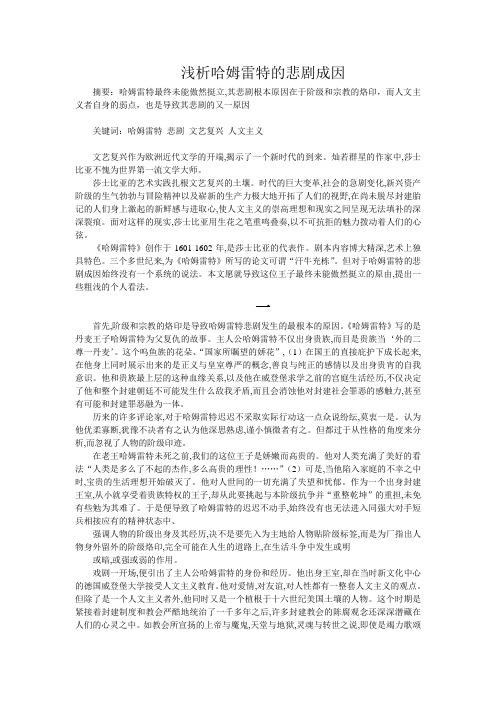
浅析哈姆雷特的悲剧成因摘要:哈姆雷特最终未能傲然挺立,其悲剧根本原因在于阶级和宗教的烙印,而人文主义者自身的弱点,也是导致其悲剧的又一原因关键词:哈姆雷特悲剧文艺复兴人文主义文艺复兴作为欧洲近代文学的开端,揭示了一个新时代的到来。
灿若群星的作家中,莎士比亚不愧为世界第一流文学大师。
莎士比亚的艺术实践扎根文艺复兴的土壤。
时代的巨大变革,社会的急剧变化,新兴资产阶级的生气勃勃与冒险精神以及崭新的生产力极大地开拓了人们的视野,在尚未脱尽封建胎记的人们身上激起的新鲜感与进取心,使人文主义的崇高理想和现实之间呈现无法填补的深深裂痕。
面对这样的现实,莎士比亚用生花之笔重鸣叠奏,以不可抗拒的魅力拨动着人们的心弦。
《哈姆雷特》创作于1601-1602年,是莎士比亚的代表作。
剧本内容博大精深,艺术上独具特色。
三个多世纪来,为《哈姆雷特》所写的论文可谓“汗牛充栋”。
但对于哈姆雷特的悲剧成因始终没有一个系统的说法。
本文愿就导致这位王子最终未能傲然挺立的原由,提出一些粗浅的个人看法。
一首先,阶级和宗教的烙印是导致哈姆雷特悲剧发生的最根本的原因。
《哈姆雷特》写的是丹麦王子哈姆雷特为父复仇的故事。
主人公哈姆雷特不仅出身贵族,而目是贵族当‘外的二尊一丹麦’。
这个呜鱼族的花朵、“国家所瞩望的娇花”,(1)在国王的直接庇护下成长起来,在他身上同时展示出来的是正义与皇室尊严的概念,善良与纯正的感情以及出身贵宵的自我意识。
他和贵族最上层的这种血缘关系,以及他在威登堡求学之前的宫庭生活经历,不仅决定了他和整个封建朝廷不可能发生什么敌我矛盾,而且会消蚀他对封建社会罪恶的感触力,甚至有可能和封建罪恶融为一体。
历来的许多评论家,对于哈姆雷特迟迟不采取实际行动这一点众说纷纭,莫衷一是。
认为他优柔寡断,犹豫不决者有之认为他深思熟虑,谨小慎微者有之。
但都过于从性格的角度来分析,而忽视了人物的阶级印迹。
在老王哈姆雷特未死之前,我们的这位王子是娇嫩而高贵的。
莎士比亚 哈姆雷特的思想 [论莎士比亚《哈姆雷特》中的人文主义思想]
![莎士比亚 哈姆雷特的思想 [论莎士比亚《哈姆雷特》中的人文主义思想]](https://img.taocdn.com/s3/m/8e3d2528ec630b1c59eef8c75fbfc77da269978a.png)
莎士比亚哈姆雷特的思想 [论莎士比亚《哈姆雷特》中的人文主义思想]摘要:莎士比亚是文艺复兴时代英国乃至整个欧洲最伟大的资产阶级人文主义作家。
在西方戏剧史和世界文学中享有崇高的地位。
他的作品深刻的反映了16世纪至17世纪的英国现实,集中代表了整个欧洲文艺复兴的文学成就,为世界文学做出了巨大的贡献。
《哈姆雷特》是莎士比亚最著名的悲剧之一代表了莎士比亚最高的艺术成就。
本文主要通过对悲剧《哈姆雷特》的创作背景及内容的分析与研究来探索莎士比亚的人文主义思想表现及其意义。
关键词:莎士比亚;《哈姆雷特》;人文主义一、《哈姆雷特》的创作背景1.1 人文主义的诞生及其发展人文主义有很深的历史渊源。
其中的人本思想和理性精神来自古希腊罗马文化,其平等、博爱的思想来自基督教精神。
近代欧洲人文主义思想诞生于文艺复兴时期的意大利。
人文主义(也叫人本主义)是文艺复兴的核心思想。
人文主义精神是一种乐观向上、积极进取的人生观和价值观。
它反对教会的来世观念和禁欲主义,肯定人的崇高地位,主张一切以"人"为本,要求把人的思想、感情、智慧从宗教神学的束缚中解放出来,肯定现世生活,歌颂爱情和个性解放,针对封建压迫和封建等级制度,人文主义鼓吹仁慈、博爱,纯真的友谊和崇高品德,提倡个性自由。
总之,人文主义反映了新的时代精神,它体现出了意气风发,朝气蓬勃和乐观进取的精神,极大地冲击了腐朽的封建思想文化,为人们的精神世界开辟了一个崭新的天地。
人文主义在意大利诞生以后,就开始不断地向外传播,并且不断的得到发展。
大约在15世纪、16世纪传到英国。
人文主义思想在欧洲得到了广泛的传播同时,也不断地为愈来愈多的人所接受。
莎士比亚就生活在这个封建制度开始瓦解,新兴资产阶级开始上升的大转折时期。
当时中世纪以宗教神学为代表的蒙昧主义思想走向没落,资产阶级以个人主义为中心的世界观日益深入人心,"人文主义"在社会思潮中开始占据统治地位。
正是在这个背景下莎士比亚写出了悲剧《哈姆雷特》来反映资产阶级人文主义思想同封建势力的较量和斗争,大胆地批判封建制度的残酷黑暗及对人性的禁锢,并以先进力量的暂时失败为结局,来控诉封建等级制度和封建思想的罪恶。
《哈姆雷特》的感情构架
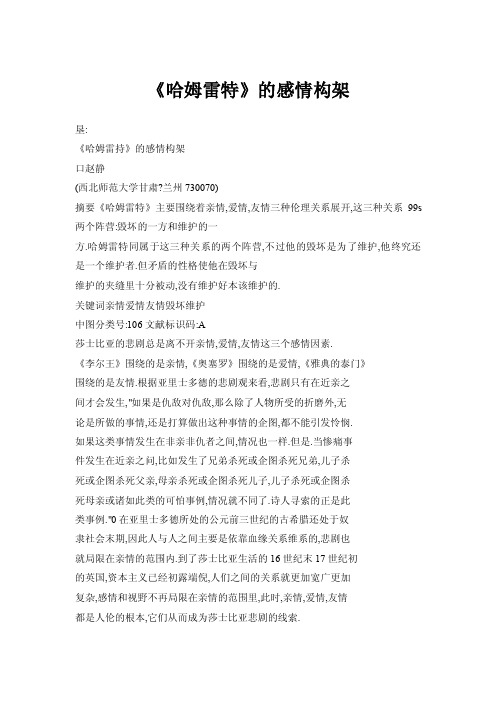
《哈姆雷特》的感情构架垦:《哈姆雷持》的感情构架口赵静(西北师范大学甘肃?兰州730070)摘要《哈姆雷特》主要围绕着亲情,爱情,友情三种伦理关系展开,这三种关系99s 两个阵营:毁坏的一方和维护的一方.哈姆雷特同属于这三种关系的两个阵营,不过他的毁坏是为了维护,他终究还是一个维护者.但矛盾的性格使他在毁坏与维护的夹缝里十分被动,没有维护好本该维护的.关键词亲情爱情友情毁坏维护中图分类号:106文献标识码:A莎士比亚的悲剧总是离不开亲情,爱情,友情这三个感情因素.《李尔王》围绕的是亲情,《奥塞罗》围绕的是爱情,《雅典的泰门》围绕的是友情.根据亚里士多德的悲剧观来看,悲剧只有在近亲之间才会发生,"如果是仇敌对仇敌,那么除了人物所受的折磨外,无论是所做的事情,还是打算做出这种事情的企图,都不能引发怜悯.如果这类事情发生在非亲非仇者之间,情况也一样.但是.当惨痛事件发生在近亲之问,比如发生了兄弟杀死或企图杀死兄弟,儿子杀死或企图杀死父亲,母亲杀死或企图杀死儿子,儿子杀死或企图杀死母亲或诸如此类的可怕事例,情况就不同了.诗人寻索的正是此类事例."0在亚里士多德所处的公元前三世纪的古希腊还处于奴隶社会末期,因此人与人之间主要是依靠血缘关系维系的,悲剧也就局限在亲情的范围内.到了莎士比亚生活的16世纪末17世纪初的英国,资本主义已经初露端倪,人们之间的关系就更加宽广更加复杂,感情和视野不再局限在亲情的范围里,此时,亲情,爱情,友情都是人伦的根本,它们从而成为莎士比亚悲剧的线索.《哈姆雷特》之所以成为莎翁剧的典范,我认为是与它在亲情,爱情,友情所有这些方面都产生了剧烈的戏剧冲突分不开的.《哈姆雷特》里的人物关系复杂而充满矛盾,莎士比亚构建感情戏剧冲突主要是由毁坏的一方和维护的一方构成的,这两个阵营互相矛盾又互为映衬,但它们又不是绝对对立的,一个人物有时同时处于这两个阵营之中.在亲情的范围里,毁坏的一方主要是克劳狄斯,但也有哈姆雷特.克劳狄斯在亲情的伦理范畴可说是罪大恶极,他为了夺得皇权和兄嫂残忍地毒死了兄长,又为了巩固窃来的王权阴谋害死侄子. 哈姆雷特虽说是为父报仇,但他毕竟也亲手杀死了自己的叔父,王室内部的仇杀构成了《哈姆雷特》的主线.毁坏者必有维护者与他抗争,否则世界将被彻底毁灭.《哈姆雷特》中对亲情的维护者是雷欧提斯,同时也有哈姆雷特.雷欧提斯与哈姆雷特的性格截然相反, 同样是复仇,他一得知父亲惨死于哈姆雷特刀下,妹妹疯死于对哈姆雷特的痴情,就迫不及待地找哈姆雷特决斗,不料被克劳狄斯利用,死于毒剑.哈姆雷特为父报仇则省慎的多,他的心理和行动都进行了一次漫长的旅行.但结果却与雷欧提斯并无二致,如果不是克劳狄斯的阴谋和雷欧提斯的卤莽.哈姆雷特的复仇计划不知还要拖延到什么时候.雷欧提斯和哈姆雷特虽然都是亲情的维护者,但是一个太卤莽轻信,一个又太优柔寡断,所以虽然最终惩罚了亲情的毁坏者从而维护了亲情,但也牺牲了自己和他人,造成了悲剧.爱情方面,第一个毁坏者是哈姆雷特的母亲乔特鲁德,她在丈夫死后不过两个月就违背誓言嫁给雷欧提斯,这大大地刺激了哈姆雷特,使他对所有女人的爱情坚贞程度产生怀疑,最终导致奥菲利亚的悲剧.第二个毁坏者则是哈姆雷特,他的言行导致对他一往情深的奥菲利亚因绝望而发疯自杀.哈姆雷特之所以对奥菲利亚冷酷无情,一方面是由于因母亲对爱情的背叛而武断地对女人产生成见, 另一方面是由于复仇计划的需要,但无论如何这都是自私和不负责任的表现.第三个毁坏者是克劳狄斯,他为毒死哈姆雷特而准备的毒酒被乔特鲁德误喝,他当时虽然试图阻止乔特鲁德喝那杯毒酒, 174文章编号:1672—7894(2008)05—174—01却因为胆怯和阴谋而没说出那是毒酒,从而导致了乔特鲁德的死亡.克劳狄斯和乔特鲁德之间无论是爱情也好是情欲也好,由于是通过阴谋和背叛实现的,所以始终被人们唾弃,但我认为克劳狄斯对乔特鲁德是有爱情的,乔特鲁德即使美貌也不再年轻,如果只是为了情欲.克劳狄斯不会选择乔特鲁德,并在害死王兄自己称王不到两个月就不顾舆论压力迫不及待地娶来自己的嫂子.但是克劳狄斯最终为了政治野心还是牺牲了乔特鲁德,这不能不说是他对爱情的背叛和毁坏.在《哈姆雷特》中对爱情最为痴迷和珍惜的是一个单纯的弱女子一奥菲利亚,她对哈姆雷特和爱情都报了太高的希望和幻想,哈姆雷特甚至是她的偶像,但正是她的偶像无情地摧毁了她的一切美好愿望,使她在绝望中发疯而死.另一方面来讲,哈姆雷特也是一个爱情的维护者,他原本对爱情也抱着极大的希望,只是由于母亲行为的刺激才由一个极端走向另一个极端,所谓爱之愈深恨之愈切,他所痛恨的是虚假软弱的爱情,由于太武断多疑误伤了最亲近的爱人.但我认为也有另一个可能,哈姆雷特也许是为了保护奥菲利亚不受自己复仇计划的牵连才对她那么冷淡的,因为要复仇就生死未,他要奥菲利亚去修道院也许出于对日后的考虑,自己如果报仇不成反而被杀,奥菲利亚就避开了与他的牵连而且也不会太伤心;如果活着,可以再接她回来,但万没想到却因此害死了奥菲利亚.无论是什么原因,哈姆雷特都是用爱情杀死了爱情,他必然是无限忏悔的.友情这条线在《哈姆雷特》中不是主线,表现的不多,但也始终贯穿在其中.毁坏的一方是哈姆雷特的两个朋友——罗森格兰兹和吉尔登斯吞,他们也是丹麦的朝臣,为了获得新王的信任从而获得更大的权力和利益,他们不惜背叛和加害哈姆雷特.同时,哈姆雷特以牙还牙,最终将他们置于死地,他们虽然死有余辜,但毕竟也算是哈姆雷特的朋友,哈姆雷特在被动的情形下破坏了友谊.维护一方的代表是霍拉旭,他从头至尾一直忠于哈姆雷特,处处帮助哈姆雷特,甚至在哈姆雷特死时要为友谊殉葬,他是莎士比亚笔下朋友的典范.哈姆雷特对这样的朋友也给予了充分的信任和钟爱,把自己最隐私,关系到自己生死存亡的秘密都告诉他,并将自己死后的名誉交给他澄清,对于真诚的友谊他是倍加信任和珍惜的.以上可以看出哈姆雷特在亲情,爱情,友情的毁坏和维护两个阵营中都有一席之地,可实质上他是一个忠心的维护者.他对毁坏者的惩罚和报复虽然无意中破坏了他所维护的东西,但他的"破" 是为了"立",为了更好的遵守,恰似法律的功用.不过他似乎始终都是被动的.别人怎么对他,他就怎么对别人,激情太多,理智不足, 随意性太大,预见性太少,这是一种不成熟的表现.他只有招架迫害的聪明却缺乏主动进攻的谋略,他无心毁坏却必须必然毁坏,他有意维护,却往往无力无法维护,这是哈姆雷特的生存困境和矛盾.也是莎士比亚留给后世思考的人生悲剧.注释:①亚历士多德.陈中梅译诗学.北京:商务印书馆,1996:105。
西方文学名著导引论文:哈姆雷特人物形象分析

评价《哈姆雷特》摘要:《哈姆雷特》一直以来被誉为莎士比亚的巅峰之作。
这部作品取材于一个王子阿姆莱斯的故事,该故事来源可追溯到12世纪。
本文从哈姆雷特的性格和语言为主要研究对象,深受人文主义的影响,忧郁的王子不仅身处孤立无援的地步,而且精神上更是备受煎熬。
关键词:哈姆雷特、孤独忧郁、人文主义、语言特点一、孤独忧虑的归国王子哈姆雷特王子的悲剧人生自一次生活突变开始了。
短短一个多月间,父王暴卒,母后改嫁,王位继承权他落别家,却只能眼睁睁看着一切无可避免的流失,无法挽回。
孤苦,忧虑,对个人生活的脱节的郁闷便成为他生活唯一可抓住的东西。
在刚出场时,哈姆雷特那一身的黑衣与宫廷的富丽堂皇形成强烈,鲜明的对比。
纵观全局,能算上哈姆雷特的朋友的,为他提供帮助的只有霍达旭。
虽然“他是为糊涂的群众所喜爱的”,在国王眼中“一般民众对他都有很大的好感,把他所有的错处都变成优点。
我的箭太轻太没有力了,遇到这样的狂风,一定不能射中目标。
反而给吹了转来。
”;虽然雷欧提斯的聚众造反说明了社会的矛盾激化和动荡不安;但哈姆雷特始终都放弃了极具现实意义的民众暴动策略。
不仅是由于他不愿意,而且更是因为在那最初的打击后他的不知所措,傍徨无助。
对此,他以反讽,黑色幽默来消解和打击。
“葬礼中剩下的残羹冷炙,正好宴请婚筵上的宾客。
”这一语讽刺了叔嫂的乱伦;“嗯,先生;在这世上,一万个人中间只不过有一个老实人。
”这一句戳穿老波洛涅斯的虚伪。
自己的母亲乱伦背德,背叛了父亲,嫁给了那个弑夫掠国的凶手,自己那洁白无辜的情人也不理解自己,反而任自己的敌人利用并帮其隐瞒。
自己以前的老朋友甘愿受新王的指使刺探并加害自己。
哈姆雷特何其孤独;何其无助。
又几多的忧郁烦闷。
二、、《哈姆雷特》的人文主义思想及其意义哈姆雷特是个具有先进理想并勤于思索的人文主义者。
他的理想和严酷的现实发生了尖锐的矛盾。
精神的危机,理想的破灭,使他悲郁愤懑,痛苦异常,也促使他不断思索,加深对社会的认识。
《哈姆莱特》

《哈姆莱特》《哈姆莱特》是莎士比亚的四大悲剧之一,也被誉为世界文学史上最伟大的戏剧之一。
这部作品描绘了丹麦王子哈姆莱特遭遇父王被杀、叔叔篡位、母后另嫁叔叔等种种不幸遭遇后的内心挣扎与复仇经历。
以下将对《哈姆莱特》及其主题、人物、结构等方面进行深入分析。
首先,我们来谈论《哈姆莱特》的主题。
整部戏剧贯穿着复仇主题,哈姆莱特为父王报仇的故事线贯穿始终。
此外,作品中还涉及到了背叛与欺骗、疯狂与正常、命运与自由等主题。
莎士比亚通过对这些主题的探讨,展现了人性的复杂性和矛盾性,引起人们对道德、命运和人生意义的深思。
接着,让我们来看看《哈姆莱特》中的几位关键人物。
首当其冲的是主人公哈姆莱特,他是一个典型的思想家,常常陷入对命运、人生、死亡等问题的深度思考。
他的犹豫不决、内心挣扎是这部戏剧的核心之一。
而哈姆莱特的母亲——格特鲁德皇后,是一个复杂并备受争议的人物,她的再婚引发了诸多复杂问题。
另外,还有哈姆莱特的叔父——克劳迪斯国王,他是这部戏剧的反面人物,通过他的野心和欺骗,导致了全剧的悲剧发展。
最后,我们来讨论一下《哈姆莱特》的结构。
这部戏剧采用了戏中戏的手法,在戏剧中穿插了一出类似于哈姆莱特父王被杀的故事,以此影射哈姆莱特现实中的遭遇。
此外,戏剧中的七幕戏剧也采用了五幕制,每一幕都有着自己的高潮和发展,使整个剧情紧凑而又富有张力。
总的来说,《哈姆莱特》作为莎士比亚的代表作之一,不仅在文学历史上占据着举足轻重的地位,同时也深刻地揭示了人性的复杂性和悲剧的无奈。
通过对主题、人物、结构等多个层面的审视,我们可以更好地理解这部不朽的经典,感受其中的思想碰撞和情感激荡。
愿我们能在《哈姆莱特》中找到属于自己的答案与启示。
精选最新分析莎士比亚戏剧《哈姆雷特》的艺术特色 论文3篇

关键词:莎士比亚戏剧家悲剧哈姆雷特人文主义摘要:威廉·莎士比亚是英国文艺复兴时期最伟大的戏剧家。
作为戏剧艺术大师,他的戏剧,无论是历史剧、喜剧,还是悲剧,都达到了世界文学的顶峰。
《哈姆雷特》是莎士比亚最著名的悲剧之一,代表了莎士比亚最高的艺术成就。
剧中莎士比亚塑造的著名人物哈姆雷特,连同罗密欧和朱丽叶等700余典型的人物形象一起已被列入世界文学的艺术画廊。
本文主要通过对悲剧《哈姆雷特》及其艺术风格的分析与研究来探索莎士比亚的人文主义思想及其对世界文学发展的贡献。
威廉·莎士比亚(1564-1616)是英国文艺复兴时期伟大的戏剧家和诗人。
他于1564年4月23日出生在英格兰中部沃里克郡埃文河畔的斯特拉特福镇,在那里度过了他的童年时期。
父亲是一个商人,曾任过斯特拉特福镇的镇长。
少年时代在当地文法学校接受基础教育,先后学习拉丁文、哲学和历史等。
莎士比亚自幼就接触过戏剧,不断有一些著名的剧团来他家乡巡回演出,这些演出使他对戏剧产生了浓厚的兴趣,培养了他对戏剧的爱好。
在文法学校,他经常在课下研读古罗马剧作家的作品,尝试练写诗歌。
14岁时,由于他父亲陷入债务,家道中落,莎士比亚不得不辍学谋生。
他18岁结婚。
1586年,他离开家乡,赴伦敦谋生。
开始当过一家剧院的打杂工,在戏剧中扮演一些小角色。
在繁忙的演员生活之余,他开始从事剧本改编和创作。
在16世纪末叶,莎士比亚已经成为一位成功的作家。
一、莎士比亚的文学生涯1590年至1600年是莎士比亚戏剧创作的第一时期,莎士比亚初试创作,本时期是他的人文主义世界观的形成期,在此期间,他写了许多历史剧、喜剧和很少几部悲剧,这些剧作大都体现了人文主义思想。
主要代表作为:《查理三世》,《仲夏夜之梦》,《威尼斯商人》,《第十二夜》,《罗密欧与朱丽叶》和《皆大欢喜》。
1601年至1608年为莎士比亚戏剧创作的第二时期,本时期是莎士比亚创作的辉煌时期。
在此期间,莎士比亚的文艺思想变得更加成熟,他的创作艺术也达到了巅峰阶段,他创作了不朽的四大悲剧:《哈姆雷特》《奥瑟罗》《李尔王》和《麦克白》。
《哈姆雷特》

戏剧:
戏剧是一种在舞台上表演且综合性很强的艺 术形式,它主要通过剧中人物台词来体现和 推动情节发展,而情节又是人物性格发展的 历史——是由人物与人物、人物与环境之间 的相互关系和作用而产生的人物的行动和事 件。借助于台词来把握戏剧情节是我们学习 戏剧的主要方式。但由于人物对话多,有时 读完后情节不能清晰地呈现在读者脑中,而 分析人物间关系可帮助我们熟悉剧情,把握 人物的心理及命运走向。
入王室之间的阴谋,所以他成
了哈姆雷特的传声筒,莎翁用
他来烘托剧情。他也是唯一一
个活到全剧结束的兰和盖登思邓 Rosencrantz & Guildernstern—— 都是哈姆雷特大学中的 老同学。他们被克劳地招来照看哈姆雷特。 虽然两人在剧中的作用不大,但王子很快就 猜疑两人是间谍。当国王下密令要处死远在 英国的哈姆雷特时,他把名字偷换了。于是 两人在幕后莫名其妙地死去。 福丁布拉斯 Fortinbras—— 挪威王子。在 剧中只有短短的过场戏。但他的重要性在于, 全剧的最后台词由他说出,似乎象征着一个 更为光明的未来,阐述了剧作主题。
全剧剧情:
《哈姆雷特》描述丹麦王驾崩,守夜卫兵看见 老王幽魂出现,告知哈姆雷特王子。而叔父 克劳迪服丧未满,即娶其兄嫂继承王位。王 子与幽魂对话,获知叔父谋害父王之真相, 王子装疯卖傻为证实真相,导演一出老王被 毒杀短剧,请新王与新后观赏,叔父当场色 变,母后以为王子疯了。王子在质问母亲的 时候误杀了大臣,也是自己恋人的父亲波洛 涅斯。奥菲莉亚遭情人失踪及丧父之痛投河 自杀,引起兄长雷奥提斯心头之恨,与克劳 迪王共谋比剑时涂剧毒于剑锋,酒内下毒, 加害王子,不料被皇后误饮,雷奥提斯自己 亦为毒剑所伤,临死告知王子真相,王子报 了父仇,自己亦壮烈牺牲。
哈姆雷特论文摘要

摘要《哈姆雷特》是文学研究领域最具争议的作品之一。
作为莎士比亚四大悲剧剧之一,它以主人公复杂的性格特点以及人文主义者身份而闻名,情节跌宕起伏。
本论文通过对文本的深刻分析,我将对哈姆雷特的逐渐成长过程进行尝试性的分析,哈姆雷特从一个天真快乐王子到一个成熟的挪威王子具有成熟的人文主义思想,这种颠覆性的变化来源于吞噬他的悲剧性经历。
全文由引言、结语和三个章节组成。
引言部分主要介绍了故事的主要内容和一些关于人物哈姆雷特的研究评论流派,之后的章节将介绍哈姆雷特的成长过程,最终见证一个成熟的人文主义者的诞生。
最后一些关于这部伟著的不朽因素将会被介绍以及对伟大的莎士比亚的歌颂,创造出如此流芳的作品。
关键词:理想主义、迷茫、绝望、重生、成熟的人文主义者AbstractHamlet is one of the most problematic works in the field of literature. As a profound tragedy, it is renowned for its title character’s complicated character as a member of a jumped-up trend—humanism. In this thesis, I would like to introduce the gradual improvement of his character from a naïve happy prince to a mature heir to Norway’s crown as his humanist thoughts deepen, which is owing to those biting tragically experience.The paper contains six major parts, that is, introduction, chapter one, chapter two, chapter three, conclusion.In introduction, I prefer to look back the main contents of the story and introduce some noted trends of criticism over hamlet’s character. From chapter one to chapter three, some underlying changes and nuances start to come out as for his character with the objective flowing of time, which will manifest a to-be-mature process for a real man as well as the humanism.In conclusion, I point out certain factors resulting in such a immortal hamlet and eulogize Shakespeare’s greatness in perceiving so charming a Denmark prince as a humanist.Key words: ideal ; disorientation; desperate; restart; mature humanist。
哈姆雷特之死原因

浅析哈姆雷特之死的原因摘要:戏剧《哈姆雷特》是莎士比亚四大悲剧之一,它代表了莎士比亚最高的艺术成就,本文通过对哈姆雷特的性格缺陷和当时的社会环境两个方面来分析哈姆雷特致死的原因。
关键词:优柔寡断怀疑猜忌忧郁社会原因引言:莎士比亚是英国文学之父。
《哈姆雷特》是莎士比亚戏剧作品中最成功的一部悲剧,他所塑造的主人公哈姆雷特的艺术形象代表了莎士比亚喜剧的最高成就。
哈姆雷特代表了莎士比亚自己的社会观,反映作者的愿望。
剧本以哈姆雷特为父报仇为线索,展开了悲剧。
古往今来,众多学者都认为哈姆雷特性格上的软弱反映在行为上的延缓性是导致他悲剧的唯一原因,事实上,导致哈姆雷特之死的原因不仅仅只有其性格上的缺陷,还有社会环境方面,也是导致哈姆雷特之死的原因。
一、哈姆雷特性格弱点与缺陷正所谓是性格决定命运,哈姆雷特的死有很大程度上是由他的个性造成的。
1、优柔寡断.面对着父亲被毒杀,母亲被占有,王权被窃取,国家被觊觎的家仇国恨,哈姆雷特有着强烈的复仇愿望:“我的运命在高声呼喊,使我全身每一根微细的血管都变得像怒狮的筋骨一样坚硬。
”“安息吧,安息吧,受难的灵魂!好,朋友们,我以满怀的热情,信赖着你们两位;要是在哈姆莱特的微弱的能力以内,能够有可以向你们表示他的友情之处,上帝在上,我一定不会有负你们。
让我们一同进去;请你们记着无论在什么时候都要守口如瓶。
这是一个颠倒混乱的时代,唉,倒楣的我却要负起重整乾坤的责任!来,我们一块儿去吧。
”怒吼,宣誓,哈姆雷特用这种毅然绝然的方式表达着自己复仇的坚定信念。
然而另一方面,哈姆雷特对杀死仇人这一看似简单的举动却表现出了常人难以理解的疑虑情结,他本来有好几次杀死仇人的绝佳机会,但在这种情结的作祟下,复仇计划一次次功亏一篑。
当他偶遇到仇人在为自己的罪孽祈祷时,复仇的想法只是一闪而过,接着他就转入了时机价值的思考:“现在我正好动手,他正在祷告。
我现在就干,他就一命归天,我也就报了仇了。
这需要算一算。
2021学年统编版必修下册《哈姆雷特(节选)》课文详及教案设计

(一)课文分析《哈姆莱特》大致创作于1600―1601年,故事原型取材于13世纪的历史著作《丹麦史》中记载的“阿姆莱特复仇记”。
在莎士比亚笔下,这个古老的中世纪传说被转变为一部不朽的经典戏剧,与莎士比亚在他的“悲剧时期”(1600―1608)创作的其他几部名作(《奥赛罗》《李尔王》《麦克白》)一起,被看作是西方最伟大的悲剧作品。
与其他作品相比,《哈姆莱特》又显得格外复杂、费解甚至神秘。
四百多年来,对这部作品的探讨和争论从未停止,包括歌德、柯尔律治、屠格涅夫、别林斯基、布拉德雷、艾略特、布鲁姆在内的众多名家大师,都针对《哈姆莱特》的思想主旨和艺术特点,提出过各式各样不同的观点。
可以说,也正是这历时四百多年的讨论,使得《哈姆莱特》不仅成为文学史上的一部经典,同时在西方的思想文化传统中,也占据了十分重要的位置。
围绕《哈姆莱特》的讨论,其中心问题是如何理解哈姆莱特这个人物,特别是如何理解他复仇的“拖延”。
哈姆莱特迟迟不进行复仇,以至于连他本人在第四幕中也责备自己:“现在我明明有理由,有决心,有力量,有方法,可以动手干我所要干的事,可是我还是在说一些空话……我不知道这是为了鹿豕一般的健忘呢,还是为了三分怯懦一分智慧的过于审慎的顾虑。
”难道哈姆莱特真的是“健忘”和“怯懦”吗?对于他的拖延有什么更好的解释?同时,复仇行为的拖延又和剧情上一些似乎不近情理的地方相关联,比如哈姆莱特装疯,似乎反而白白引起国王对他的怀疑,对于完成复仇并没有什么好处;他最后杀死国王,也不是有计划、有自觉的行动,仿佛纯属一系列机缘偶合。
由于存在这些疑问,如何理解哈姆莱特的“拖延”,就成为理解《哈姆莱特》这部作品的一个关键。
歌德在《威廉迈斯特的学习时代》里从哈姆莱特本人的性格角度来解释这个问题。
在他看来,《哈姆莱特》讲的是“一件伟大的事业担负在一个不能胜任的人的身上”的故事,哈姆莱特固然“美丽、纯洁、高贵而道德高尚”,但却缺乏英雄所需要的“坚强的精力”。
小说《哈姆雷特》的叙事结构
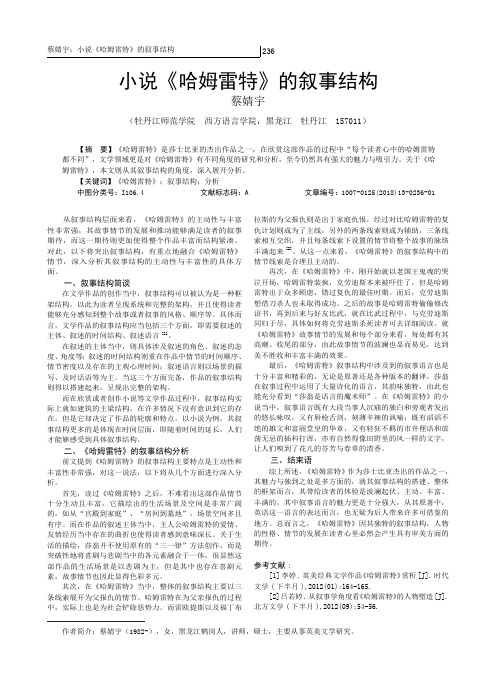
236蔡婧宇:小说《哈姆雷特》的叙事结构小说《哈姆雷特》的叙事结构蔡婧宇(牡丹江师范学院 西方语言学院,黑龙江 牡丹江 157011)作者简介:蔡婧宇(1982-),女,黑龙江鹤岗人,讲师,硕士,主要从事英美文学研究。
【摘 要】《哈姆雷特》是莎士比亚的杰出作品之一,在欣赏这部作品的过程中“每个读者心中的哈姆雷特都不同”,文学领域更是对《哈姆雷特》有不同角度的研究和分析,至今仍然具有强大的魅力与吸引力。
关于《哈姆雷特》,本文则从其叙事结构的角度,深入展开分析。
【关键词】《哈姆雷特》;叙事结构;分析中图分类号:I106.4 文献标志码:A 文章编号:1007-0125(2018)13-0236-01从叙事结构层面来看,《哈姆雷特》的主动性与丰富性非常强,其故事情节的发展和推动能够满足读者的叙事期待,而这一期待则更加使得整个作品丰富而结构紧凑。
对此,以下将突出叙事结构,有重点地融合《哈姆雷特》情节,深入分析其叙事结构的主动性与丰富性的具体方面。
一、叙事结构简谈在文学作品的创作当中,叙事结构可以被认为是一种框架结构,以此为读者呈现系统和完整的架构,并且使得读者能够充分感知到整个故事或者叙事的风格、顺序等。
具体而言,文学作品的叙事结构应当包括三个方面,即需要叙述的主体、叙述的时间结构、叙述语言[1]。
在叙述的主体当中,则具体涉及叙述的角色、叙述的态度、角度等;叙述的时间结构则重在作品中情节的时间顺序、情节密度以及存在的主观心理时间;叙述语言则以场景的描写、及时话语等为主。
当这三个方面完备,作品的叙事结构则得以搭建起来,呈现出完整的架构。
而在欣赏或者创作小说等文学作品过程中,叙事结构实际上就如建筑的主梁结构,在许多情况下没有意识到它的存在,但是它却决定了作品的轮廓和特点。
以小说为例,其叙事结构更多的是体现在时间层面,即随着时间的延长,人们才能够感受到具体叙事结构。
二、《哈姆雷特》的叙事结构分析前文提到《哈姆雷特》的叙事结构主要特点是主动性和丰富性非常强,对这一说法,以下将从几个方面进行深入分析。
浅析莎士比亚悲剧《哈姆雷特》的文学特色
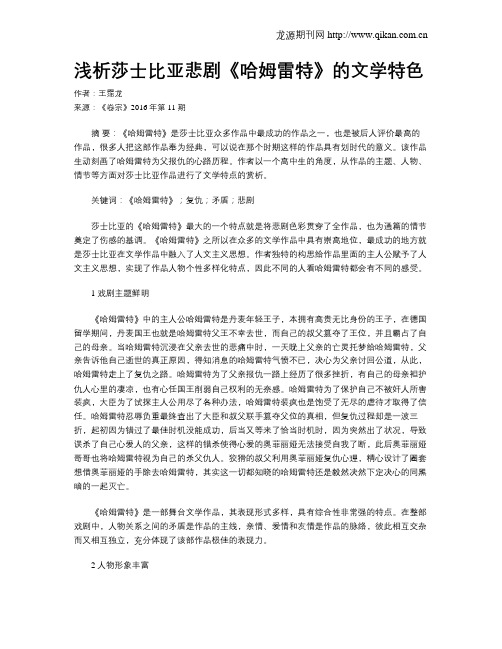
浅析莎士比亚悲剧《哈姆雷特》的文学特色作者:王霈龙来源:《卷宗》2016年第11期摘要:《哈姆雷特》是莎士比亚众多作品中最成功的作品之一,也是被后人评价最高的作品,很多人把这部作品奉为经典,可以说在那个时期这样的作品具有划时代的意义。
该作品生动刻画了哈姆雷特为父报仇的心路历程。
作者以一个高中生的角度,从作品的主题、人物、情节等方面对莎士比亚作品进行了文学特点的赏析。
关键词:《哈姆雷特》;复仇;矛盾;悲剧莎士比亚的《哈姆雷特》最大的一个特点就是将悲剧色彩贯穿了全作品,也为通篇的情节奠定了伤感的基调。
《哈姆雷特》之所以在众多的文学作品中具有崇高地位,最成功的地方就是莎士比亚在文学作品中融入了人文主义思想。
作者独特的构思给作品里面的主人公赋予了人文主义思想,实现了作品人物个性多样化特点,因此不同的人看哈姆雷特都会有不同的感受。
1 戏剧主题鲜明《哈姆雷特》中的主人公哈姆雷特是丹麦年轻王子,本拥有高贵无比身份的王子,在德国留学期间,丹麦国王也就是哈姆雷特父王不幸去世,而自己的叔父篡夺了王位,并且霸占了自己的母亲。
当哈姆雷特沉浸在父亲去世的悲痛中时,一天晚上父亲的亡灵托梦给哈姆雷特,父亲告诉他自己逝世的真正原因,得知消息的哈姆雷特气愤不已,决心为父亲讨回公道,从此,哈姆雷特走上了复仇之路。
哈姆雷特为了父亲报仇一路上经历了很多挫折,有自己的母亲袒护仇人心里的凄凉,也有心任国王削弱自己权利的无奈感。
哈姆雷特为了保护自己不被奸人所害装疯,大臣为了试探主人公用尽了各种办法,哈姆雷特装疯也是饱受了无尽的虐待才取得了信任。
哈姆雷特忍辱负重最终查出了大臣和叔父联手篡夺父位的真相,但复仇过程却是一波三折,起初因为错过了最佳时机没能成功,后当又等来了恰当时机时,因为突然出了状况,导致误杀了自己心爱人的父亲,这样的错杀使得心爱的奥菲丽娅无法接受自我了断,此后奥菲丽娅哥哥也将哈姆雷特视为自己的杀父仇人。
狡猾的叔父利用奥菲丽娅复仇心理,精心设计了圈套想借奥菲丽娅的手除去哈姆雷特,其实这一切都知晓的哈姆雷特还是毅然决然下定决心的同黑暗的一起灭亡。
浅谈文艺复兴背景下的《哈姆雷特》
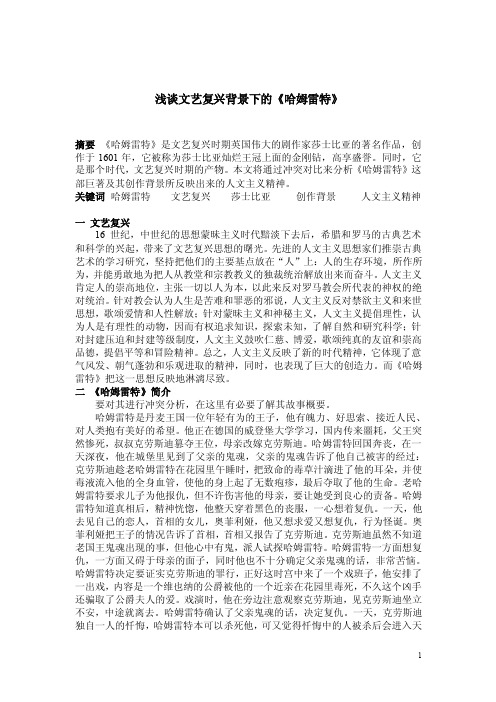
浅谈文艺复兴背景下的《哈姆雷特》摘要《哈姆雷特》是文艺复兴时期英国伟大的剧作家莎士比亚的著名作品,创作于1601年,它被称为莎士比亚灿烂王冠上面的金刚钻,高享盛誉。
同时,它是那个时代,文艺复兴时期的产物。
本文将通过冲突对比来分析《哈姆雷特》这部巨著及其创作背景所反映出来的人文主义精神。
关键词哈姆雷特文艺复兴莎士比亚创作背景人文主义精神一文艺复兴16世纪,中世纪的思想蒙昧主义时代黯淡下去后,希腊和罗马的古典艺术和科学的兴起,带来了文艺复兴思想的曙光。
先进的人文主义思想家们推崇古典艺术的学习研究,坚持把他们的主要基点放在“人”上:人的生存环境,所作所为,并能勇敢地为把人从教堂和宗教教义的独裁统治解放出来而奋斗。
人文主义肯定人的崇高地位,主张一切以人为本,以此来反对罗马教会所代表的神权的绝对统治。
针对教会认为人生是苦难和罪恶的邪说,人文主义反对禁欲主义和来世思想,歌颂爱情和人性解放;针对蒙昧主义和神秘主义,人文主义提倡理性,认为人是有理性的动物,因而有权追求知识,探索未知,了解自然和研究科学;针对封建压迫和封建等级制度,人文主义鼓吹仁慈、博爱,歌颂纯真的友谊和崇高品德,提倡平等和冒险精神。
总之,人文主义反映了新的时代精神,它体现了意气风发、朝气蓬勃和乐观进取的精神,同时,也表现了巨大的创造力。
而《哈姆雷特》把这一思想反映地淋漓尽致。
二《哈姆雷特》简介要对其进行冲突分析,在这里有必要了解其故事概要。
哈姆雷特是丹麦王国一位年轻有为的王子,他有魄力、好思索、接近人民、对人类抱有美好的希望。
他正在德国的威登堡大学学习,国内传来噩耗,父王突然惨死,叔叔克劳斯迪篡夺王位,母亲改嫁克劳斯迪。
哈姆雷特回国奔丧,在一天深夜,他在城堡里见到了父亲的鬼魂,父亲的鬼魂告诉了他自己被害的经过:克劳斯迪趁老哈姆雷特在花园里午睡时,把致命的毒草汁滴进了他的耳朵,并使毒液流入他的全身血管,使他的身上起了无数疱疹,最后夺取了他的生命。
《哈姆雷特》:复仇与疯狂的漩涡

哈姆雷特:复仇与疯狂的漩涡简介《哈姆雷特》是莎士比亚最著名的悲剧作品之一,关于丹麦王子哈姆雷特对父亲被杀以及复仇的故事。
本文将从复仇和疯狂两个主题出发,探讨《哈姆雷特》中角色们在错综复杂的情节中经历的心理变化。
复仇的动机在剧中,哈姆雷特被告知他的父亲被自己的叔叔克劳迪乌斯所害。
这个惊人的事实成为了哈姆雷特展开复仇行动的推动力。
他深陷于对克劳迪乌斯报仇的决心之中,并不断思考如何使其得到实现。
情感与道德困境然而,在复仇路上,哈姆雷特陷入了情感和道德困境。
他思考着正义和道义是否值得牺牲自己来实现,同时也疑惑着复仇将会给他带来怎样的后果。
这种内心挣扎逐渐使他变得孤独和沉思,进而导致他的精神逐渐崩溃。
疯狂与漩涡在剧中,哈姆雷特伪装疯狂来掩饰自己的目的和计划。
然而,这种伪装渐渐地转变成了真正的疯狂。
他开始表现出古怪和离奇的行为,引发人们对他精神状态的质疑。
这一心理转变不仅是因为他所面临的压力和困惑,也与其他角色对他的态度有关。
角色间相互影响与哈姆雷特有关系密切的角色也被复仇主题和哈姆雷特的心理状态所影响。
克劳迪乌斯、波罗尼厄斯以及奥菲利娅等角色纷纷陷入了混乱之中,并从中汲取了教训。
整个剧情由此构建起复杂而扣人心弦的故事。
结论《哈姆雷特》呈现了复仇与疯狂之间错综复杂的关系。
通过剧中角色们在情节发展过程中经历的心理变化,观众被推向迷人而令人深思的境地。
这部作品深刻揭示了复仇的暴力和对个体心灵所造成的巨大冲击,成为全球文学经典之一。
以上就是关于《哈姆雷特》中复仇与疯狂主题的编写内容。
希望这篇文章能够为你提供有价值的信息!。
哈姆雷特

摘要:莎士比亚是世界文学史上最伟大的诗人和戏剧家之一。
他创作了大量脍炙人口的文学作品,被誉为“人类文学奥林匹斯山上的宙斯”,他的作品以其独特的魅力穿越不同的时空,滋养了无数人的精神世界。
《哈姆雷特》便是这样一部极具魅力与复杂性的作品,数百年来吸引了无数人对其进行探究。
近年来,关于哈姆雷特是否为“人文主义者”的争议成为研究的热点,本文认为我们不能否认哈姆雷特这一形象身上确实带有某些人文主义思想的闪光点,但是我们也不能因此就将哈姆雷特定论为一个“典型的人文主义者”。
在莎士比亚的笔下,哈姆雷特只是作为一个自然存在的人,由于作者特殊的人文主义者的身份以及当时特殊的历史政治环境,使得哈姆雷特这一人物成了当时社会几种思想意识斗争的载体,透过哈姆雷特,我们可以窥见文艺复兴时期的人生百态。
关键词:哈姆雷特人文主义一.关于哈姆雷特的形象争论在莎士比亚戏剧评论400多年的发展历程中,哈姆雷特作为莎士比亚笔下最光辉的形象之一,自然就吸引了众多的目光和争论。
争论的焦点还是集中在对哈姆雷特这一形象的定位上。
无数的专家学者就“哈姆雷特是否为人文主义者”这一论题进行了多角度、多方位的探讨和论证,形成了所谓的“崇哈派”与“否哈派”。
我国学术界的主流观点认为:“哈姆雷特是人文主义者的典型形象”。
这一传统观点则来自于前苏联。
阿尼克斯特撰写的《论莎士比亚的悲剧<哈姆雷特>》一文成为了苏联的“哈评”经典之作。
文章论证指出“哈姆雷特是个人文主义者”,且认为“哈姆雷特典型地体现了先进的人们,为了把人类从压迫中解放出来,热烈地寻求途径和方法”,“是一场解放人类的光荣战斗中的一员战士”。
阿尼克斯特将哈姆雷特不能找到“改造世界的现实途径”以及哈姆雷特身上的其他缺点归结到“由于时代条件所局限”。
这一观点在我国产生了广泛而持久的影响。
卞之琳于1965年发表的《论<哈姆雷特>》,他全盘接受了阿尼克斯特的基本观点,并强化了哈姆雷特作为“人文主义战士”论证,认为哈姆雷特代表人民的利益,在与社会罪恶的斗争中显示出人道主义光辉。
- 1、下载文档前请自行甄别文档内容的完整性,平台不提供额外的编辑、内容补充、找答案等附加服务。
- 2、"仅部分预览"的文档,不可在线预览部分如存在完整性等问题,可反馈申请退款(可完整预览的文档不适用该条件!)。
- 3、如文档侵犯您的权益,请联系客服反馈,我们会尽快为您处理(人工客服工作时间:9:00-18:30)。
【摘要】《哈姆雷特》作为莎士比亚四大悲剧之首,将主人公哈姆雷特的人物性格通过其语言动作刻画的淋漓尽致,作者莎士比亚通过哈姆雷特的悲剧哀悼了文艺复兴晚期人文主义的衰落。
本文主要通过分析主人公哈姆雷特的性格来探讨其悲剧形成的根本原因
【关键词】《哈姆雷特》历史背景莎士比亚性格缺陷
一、历史背景
十六、十七世纪之交,英国正处在封建制度向资本主义制度过渡时期,这个时期是英国历史进程中的一个巨大转折。
《哈姆雷特》是借丹麦八世纪的历史反映十六世纪末和十七世纪初的英国社会现实。
当时的英国,如前所述,是一个“颠倒混乱的时代”,而《哈姆雷特》正是“这个时代的缩影”。
剧中哈姆雷特与克劳迪斯的斗争,象征着新兴资产阶级人文主义者与反动的封建王权代表的斗争。
通过这一斗争,作品反映了人文主义理想同英国黑暗的封建现实之间的矛盾,揭露了英国封建贵族地主阶级与新兴资产阶级之间为了争夺权力而进行的殊死较量,批判了王权与封建邪恶势力的罪恶行径。
文艺复兴运动使欧洲进入了“人”的觉醒的时代,人们对上帝的信仰开始动摇。
在“个性解放”的旗帜下“为所欲为”,这是当时的一种时代风尚。
这一方面是思想的大解放,从而推动了社会文明的大发展;另一方面,尤其是到了文艺复兴的晚期,随之产生的是私欲的泛滥和社会的混乱。
面对这样一个热情而又混乱的时代,人到中年的莎士比亚,已不像早期那样沉湎于人文主义的理想给人带来的乐观与浪漫,而表现出对理想与进步背后的隐患的深入思考,《哈姆雷特》正是他对充满隐患而又混乱的社会的一种审美写照。
二、莎士比亚
莎士比亚(1564―1614)出生在伊丽莎白时期艾文河畔的斯特拉夫小镇上。
他的父亲是当地一个小有名气的商人,后来生意中途没落,最终没有步入大资产阶级之列。
年轻时的莎士比亚做过屠夫、商人。
他所受教育程度不高,但内心始终有一种改变生活状态,进入高级阶层社会的需求与向往,并以此获得超越自我,追求自我价值的实现。
莎士比亚离开家乡,来到充满文学、戏剧氛围的伦敦,在此他的文学创作天分得到了充分的施展,最终使他踏上了通向文学的巅峰之路。
处于社会底层的莎士比亚处于一种心理焦虑状态,他渴望同他人在一起,建立友好的关系,尤其渴望被社会接纳,从事一种被欣赏、有尊严的工作。
戏剧和诗歌是他最好的选择。
他积极接受伊丽莎白时期人们对美的观念,用唯美的方式表达对美的理解和对文学艺术的膜拜。
在《第十八首十四行诗》中,他使用伊丽莎白式十四行诗描述了爱人那不可言喻的美,并歌颂了文学能战胜自然,使美永存人世的特殊功能。
三、哈姆雷特的性格分析
(一)忧郁
1.忧郁之根源
一系列残酷的事件突然发生,打破了他关于人生、世界、爱情、友谊、前途等一系列人文主义的幻想。
然而父亲的死,母亲的改嫁,朋友的背叛等等让哈姆雷特觉得:人类,并不
美好,下贱的克牢狄斯一旦爬上王位,很多人将会对他阿谀奉承,为了篡权,弟弟居然暗杀自己的哥哥……所以,他无法理解。
2.忧郁之长久
从他穿着丧服登场,到破相装疯,到戏中作戏,到后宫劝母,到海上窥奸,到墓场葬礼,到宫廷比武,一直到他最后毁灭,忧郁一直没有离开过他。
所以,没有忧郁,也就没有哈姆雷特。
(二)犹豫
1.犹豫意愿――敌强我弱,任务艰巨。
2.犹豫表现――拙于行动,不知如何行动。
3.犹豫结果――空有报国志心,而无匡世之策,只落得个苦闷彷徨,忧郁,犹豫。
(三)多疑
他多疑的性格,由其母后改嫁,对其父亲的背叛,他开始怀疑女性,怀疑爱情,这也最终导致了奥菲利亚精神失常以及落水身亡。
他的多疑性格是由于其理想与现实之间巨大而不可更改的差距导致的。
(四)优柔寡断
哈姆雷特这个高贵的丹麦王子,长于哲理思考,但是却隐于行动。
其性格缺陷便是优柔寡断,在复仇上,不断地思前想后,从而错过了很多复仇的良机。
(五)善良
在巨大的灾难降临到哈姆雷特身上时,,他的人民还是非常欢迎他,爱戴他,不管是什么阶层的人,不管是他喜欢的人,还是不喜欢的人,哈姆雷特都以礼相待,表现出谦逊与和蔼。
比如,不管是对军官马西勒斯、勃那多还是兵士弗兰西斯科以及他的好友,他总是以诚相待,面对他们总是笑容可掬,说:我的朋友,很高兴看见你的身体健康……
四、悲剧的结局
文艺复兴后,由于人的觉醒和个性的解放,人由神本世界回到人本世界,人自身的性格成了描写的主要对象,性格的缺点常常成为悲剧的主要原因。
《哈姆雷特》其实是一个典型的悲剧性格,面对他无法言说的亲情、爱情以及理想困境时,最终才导致了在最后的比剑中,中毒而死。
一种人靠本能生存,一种是靠思考生存,本能使人强大,思考却使人脆弱。
靠本能,急缺行动的便是勒替斯,他敢于行动,但是头脑简单,好冲动,盲目,成为克劳迪斯的工具。
但是在莎士比亚的笔下,本能和思考都能带来相同的毁灭。
这就说明了人本来就有其自身的性格缺陷,先天的就无法完美,因此其悲剧就更带有必然性。
五、结语
处于人文主义思潮泛滥的时代,哈姆雷特表现出了异乎常人的精明,他冷静的分析自己的处境,并想要找到复仇的方法,可是其复杂的人物性格最终导致了悲剧的结局。
同时,也值得我们肯定的是莎士比亚是英国现实主义文学的奠基人。
他对世界文学发展影响巨大,他的文学作品是人文主义文学最杰出的代表,蕴含着丰富的人文主义思想。
在莎士比亚的剧作
中,他真实地记载了那个时代的社会矛盾和冲突,深切地表达了他对生活在社会底层的劳苦大众的深切同情,尖锐地抨击了社会上层统治阶级的贪婪和残忍。
莎士比亚的《哈姆雷特》作为西方文学史上的一座里程碑,我们永远无法参透它的魅力,这也正是《哈姆雷特》这部作品历经沧桑,一直被世人研究的原因之一!
参考文献:
[1]施咸荣.莎士比亚和他的戏剧[M].北京:北京出版社,1981
[2]朱生豪,译.莎士比亚全集[M].人民教育出版社,1994
[3]王渤.说不尽的哈姆雷特――哈姆雷特丰富的内涵的成因分析[J].新课程研究,2007
[4]吴非.浅析哈姆雷特的人文主义形象[J].经济研究导刊,2008
转载请注明来源。
原文地址:。
